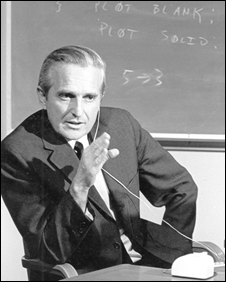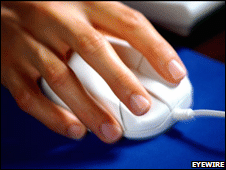The mouse hits 40-year milestone
By Mark Ward
Technology correspondent, BBC News The humble computer mouse celebrates its 40th anniversary today. On 9 December 1968 hi-tech visionary Douglas Engelbart first used one to demonstrate novel ways of working with computers.
The first mouse that Dr Engelbart used in the demo at the Fall Joint Computer Conference (FJCC) was made of wood and had one button.
Much of the technology shown off in the demo inspired the creation of the hardware and software now widely used.
"It was a good show, but it was all real," said Dr Jeff Rulifson, now director of Sun's VLSI research group but in 1968 architect and lead programmer for the software shown off at the FJCC.
Pioneering work A day of celebration is planned in California to mark the 40th anniversary; with many of the researchers behind the original demo reunited to mark the event.
The mouse, which was built by Bill English, helped Dr Engelbart demonstrate how text files could be clipped, copied and pasted as well as showing ways of using computer networks to collaborate on projects or co-edit documents.

Dr Rulifson joined the group that Dr Engelbart assembled at the Stanford Research Institute in California after meeting the charismatic engineer while attending the FJCC in 1965.
Douglas Engelbart had a clear vision of how computers should help people
"I met Doug and got thoroughly enchanted," Dr Rulifson told the BBC.
"I really understood what he was after. I was blown away by the ideas."
Dr Engelbart wanted computers to act as helpers that augmented human intelligence and enabled people to operate far more efficiently and productively than they would without such tools.
The 1968 demonstration showed off the computer system, called NLS, developed to put these ideas into practical form.
Most of this, said Dr Rulifson, had to be invented by the team at SRI.
"There were bits and pieces all around," he said. "There was no completely unique set of ideas but we pulled it all together."
Although the mouse was central to what NLS could do, said Dr Rulifson, there was more to what Dr Engelbart wanted to achieve.
"I think people get fixated on the mouse," he said. "It's a symbol they can hang on to but the idea behind it was this idea of putting text into NLS and giving it an entirely new flexibility."
"We had full text editing and hyperlinks - the mass of what we use today," said Dr Rulifson.
In the 1968 demo Dr Rulifson was at the SRI Lab and appeared on screen in Brooks Hall auditorium while helping Dr Engelbart to show how co-workers could use NLS to collaborate.
The demo was so far ahead of other uses of computers at the time and the technology on show was so powerfully convincing that one attendee later likened Dr Engelbart's efforts to "dealing lightning with both hands".
Command set Not only did NLS impress the audience at the FJCC, but it also became the first program scheduled to be used across the fledgling Arpanet that was just being built. NLS is mentioned in the first RFC - the technical documents that describe the workings of what we know today as the internet.
The basic workings of a mouse have changed little in 40 years

In 1969 SRI, along with UCLA, was one of the two ends of the first link in the network that became Arpanet - and ultimately the internet.
Sadly, said Dr Rulifson, NLS did not win enough people over to become the essential tool that Dr Engelbart envisioned.
"I think what happened was that Doug was very focused on extremely powerful systems for extremely highly-trained people," he said. "NLS had 500 single key commands."
Learning how to use NLS was a formidable task that few took on - despite its potential.
Many of the people that worked with Dr Engelbart at SRI went on to Xerox Parc - another legendary lab in California where many contributed directly to the technologies that led to the personal computer revolution and the world wide web.
Only now is Doug Engelbart's vision starting to be realised, said Dr Rulifson, and the world has yet to catch up with the ideas first aired in 1968.
"Half the vision has come along," said Dr Rulifson. "We could see the day when these things would be small enough to carry about.
"But," he added, "Doug was very frustrated with the stuff that grew up around the PC, because it's too static and paper-like."
